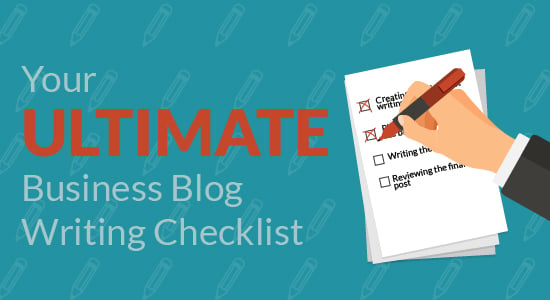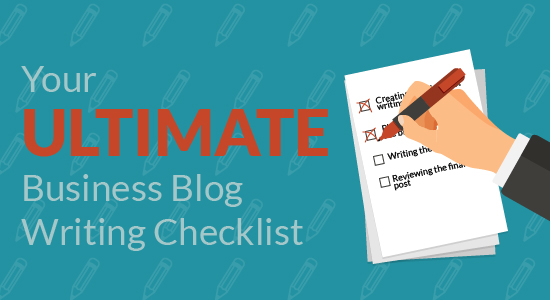Your Ultimate Business Blog Writing Checklist

Business blogs are among the three primary forms of media used in the content marketing strategies today, according to HubSpot, with both B2B and B2C brands relying on storytelling to grow awareness, increase website traffic and SEO performance, and drive lead generation.
But for business blogs to achieve those objectives, they must be targeted, informative and well-written.
The checklist that follows includes suggestions both for marketing managers assigning work to writers—in-house, agency or freelance—and for the writers themselves as they craft each individual blog post. Of course, in some small companies, the “manager” and writer may be the same person. In that case, it still pays to take time to think like a manager in drafting the assignment details before you start writing.
Creating the blog post writing assignment
Whether you are assigning the blog to a freelance writer, a team member in your office, or just fleshing out the idea for yourself, have a few basic elements nailed down before the writing begins. Many of these can also be detailed early in the blog planning process as the year’s content marketing campaigns and blog editorial calendar is put together.
Before handing off the assignment to a writer, be sure to include:
- A working title/topic. The writer should use best practices to improve it if possible.
- Section of blog or other segmentation. If your company has multiple brands, product lines or locations, you may have individual sections of the overall corporate blog dedicated to those segments. Be sure the writer knows which section this post should fit into.
- Objective or type of post. Is it company news, industry news, thought leadership, a how-to article, listicle, case study, Q& A, or something else?
- Overview of assignment and messaging. Include target length, writing style and style guides to be followed.
- Content or offer to be promoted at the end of the post.
- SEO keywords and phrases to be incorporated.
- Targeted buyer persona(s) and any additional audience information the writer should understand about the intended readers.
- Stage of the buying cycle being targeted: awareness/early engagement, consideration/evaluation, sales ready/decision, or customer communication and retention.
- Resources to be used in writing. This could include internal data, interviews with company or industry leaders, images such as related photos or infographics and existing marketing content such as videos, whitepapers and ebooks.
- Deadlines. This might be broken down into rough draft and final, or could even include an outline stage if you are working with a new writer who needs more guidance.
This list seems long, but if all of these details are in place before the writer begins, there will be less time lost in questions or rewrites because the blog post doesn’t meet the intended parameters.
Planning and researching the blog post
The writer’s checklist begins here with the planning and research necessary.
- Review the buyer persona description and audience, objective for this specific blog post and the content offer to be included.
- Review existing data and information to determine how much can be leveraged in this blog post.
- Plan brand talking points on key products, initiatives or projects to blend into the post to provide additional insight.
- Choose a blog format, if not already specified in the assignment instructions. Examples include how-to post, list, comparison, survey results, infographic, etc. (Download templates for five different blog formats here to get a head start.)
- Develop a logical outline with introduction, main points and conclusion.
- Review keywords and phrases included in instructions and SEO best practices.
- Write a headline or title following best practices including at least one selected keyword from the assignment instructions.
- Plan subheads to break up text and allow readers to easily find key points if scanning the post.
Writing the blog post
- Write an introduction that sets up the topic of the blog post and compels the audience to continue reading.
- Ensure the introduction is relevant to the target audience.
- Develop the post around at least three key points and/or tips.
- Use the body of the post to address the target audience and its needs.
- Connect the blog post to the content offer by introducing similar themes or topics to those in the offer resource.
- If possible, include at least one sourced statistic in the post.
- Include at least three links that take readers to additional information. These can be internal links to content and related marketing material on the blog or website, or they can be external links to credible third-party pages.
- Ensure text is broke into small sections with no more than 75-200 words each.
- If possible, include one bulleted or numbered list that makes information easy to digest and draws attention to key points.
- Use humor or personal experiences, or client/customer success stories, to make the post more relatable and keep the reader engaged.
- Include a conclusion that recaps the key takeaways of the post.
- In the conclusion, ask a question or encourage readers to engage with the blog post by leaving a comment.
- Write a call-to-action (CTA) for the content offer.
Reviewing the final blog post
Whether the writer is doing his or her own final review, or someone else on the team is providing objective feedback and an extra set of eyes, use this final set of questions to ensure the post is optimized to achieve its goals. Small mistakes can turn otherwise great content into the wrong impression, so it pays to pay attention to details on the final edit.
Does this blog post:
- Focus on the specified buyer personas and target market?
- Follow the company or client’s preferred style guide (e.g. Associated Press, Chicago Manual of Style)?
- Read clearly and fluidly?
- Have any grammatical or spelling errors?
- Use a consistent verb tense throughout the copy?
- Meet the word count requirements for the assignment?
- Leverage company expertise, insights and research?
- Correctly credit all sourced information and statistics?
- Contain links that work correctly?
Business blogs have the potential to be a strong tool in the content marketing toolbox, but each post needs to be approached with the goal of excellence. It needs an audience, a purpose, and quality writing. That is what this checklist can help your team turn out each and every time.
Do your writers need a little extra boost to get started (or do you simply want to speed up the process)? Using templates can be a good way to set up the structure of a blog post and quickly fill in with specific anecdotes, data, and insights. Our Inbound Marketing Learning Library includes a package of five free blog writing templates that you can download today to get started—formats for how-to, list-based, curated, SlideShare and newsjacking blog posts.
If business blog strategy and implementation is an area in which you are looking for outside assistance, I’d be glad to talk with you about the JONES team of marketing strategists and writers. You can schedule a time in my calendar here.
-1.png?width=1652&height=294&name=Jones(RGB)-1.png)












